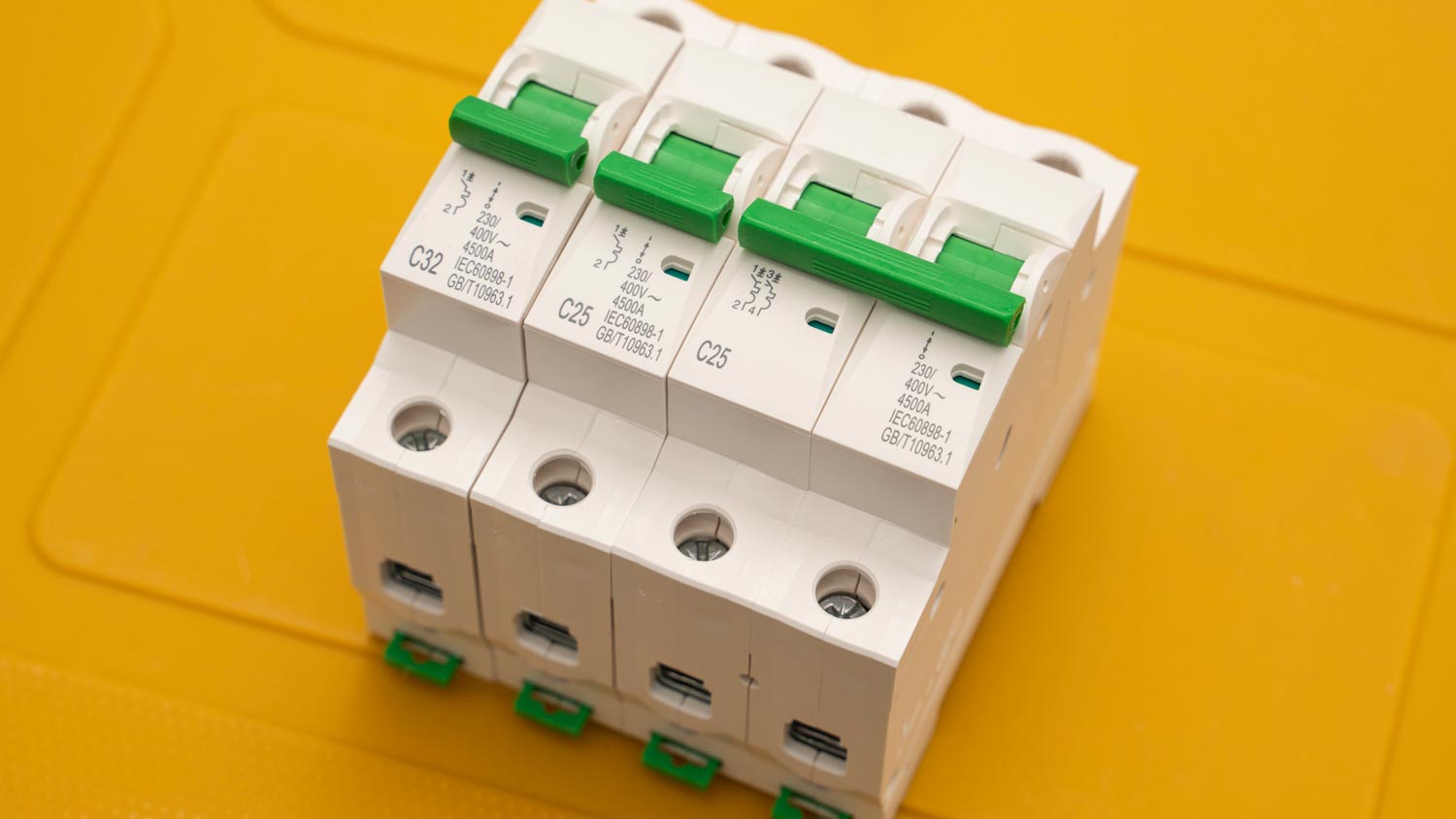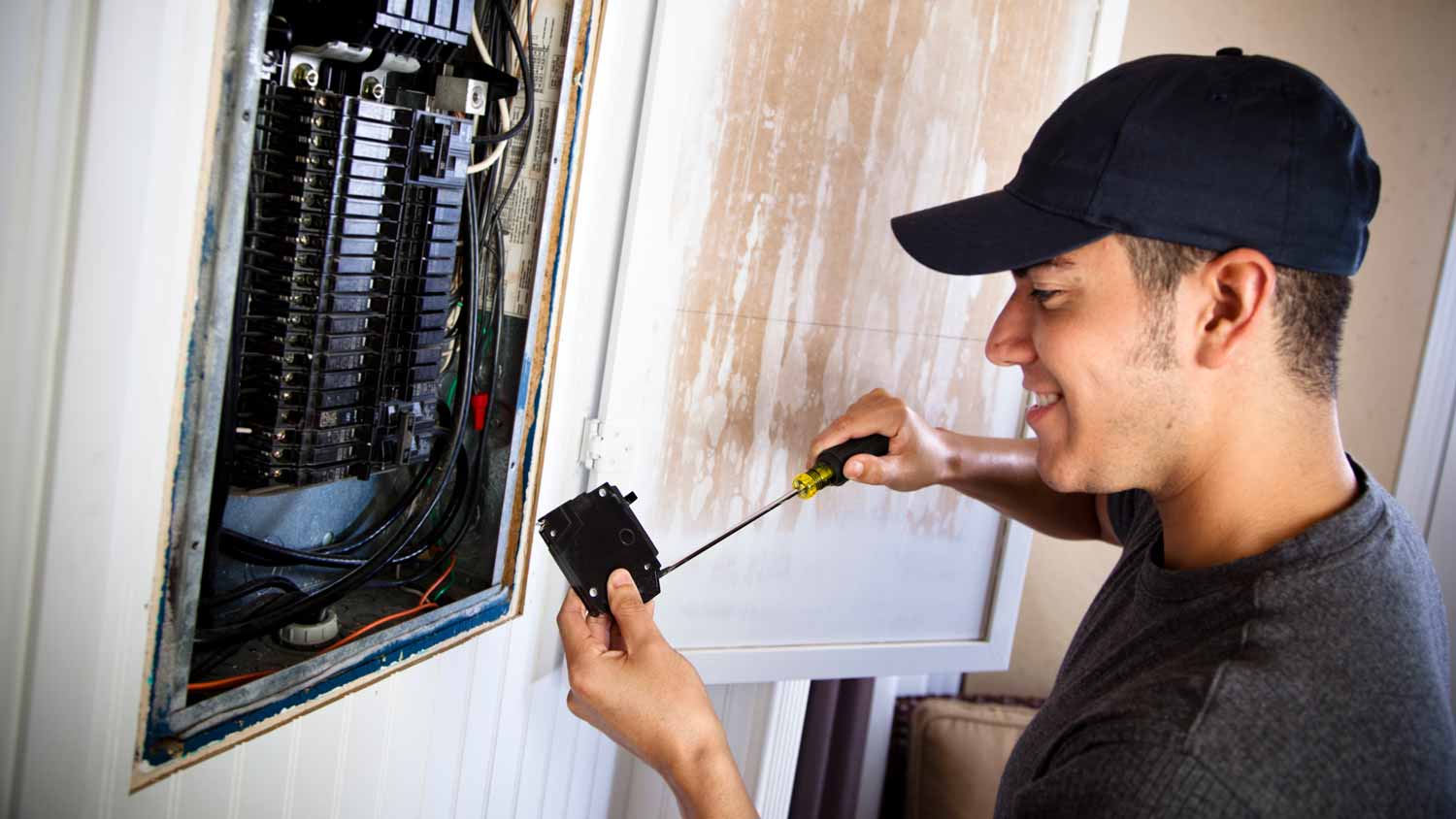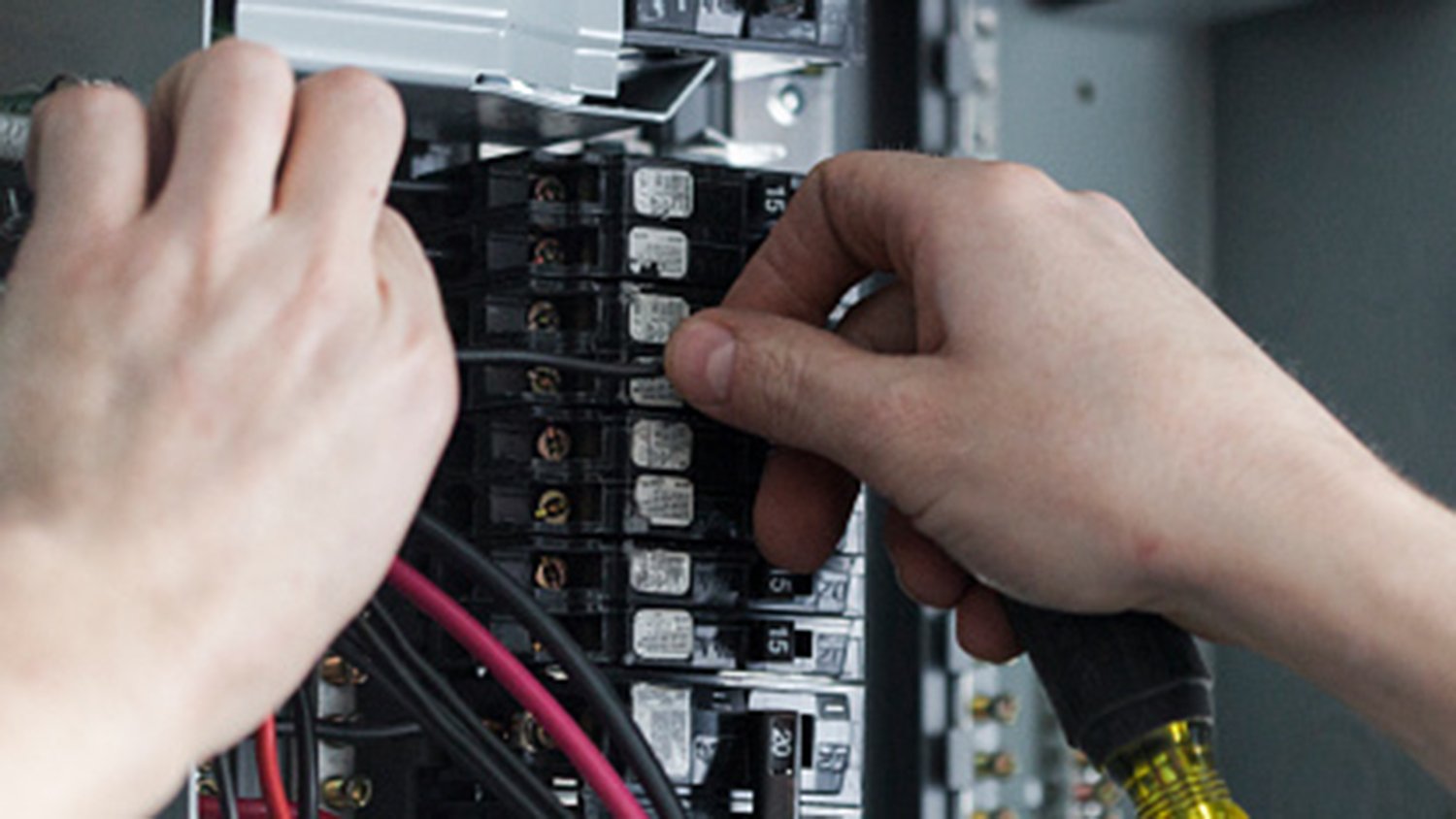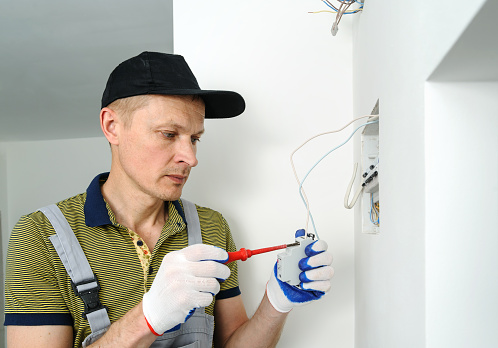
Wondering how much rewiring a house costs in Philadelphia? Learn how local codes, materials, and home age affect your final price.
Replace a circuit breaker without breaking a sweat


A professional electrician can ensure your circuit breaker is replaced correctly to prevent the risk of electrical shock and other issues.
Replacing a circuit breaker requires tools you may not have on hand, including rubber-soled boots, insulated rubber gloves, and a voltage tester.
While hiring a pro to replace a circuit breaker costs between $50 and $100 per hour, they can complete this task faster than a DIY job.
Learning how to replace a breaker can save you from minor irritations, like flickering lights and circuit breaker trips every time you plug in the vacuum cleaner. However, a wonky circuit breaker can sometimes indicate a fire or electrical shock hazard. If you DIY this replacement, work slowly and exercise extreme caution, or, better yet, hire a local electrician to ensure the job is completed safely and efficiently.

A circuit breaker is a switch that protects your electrical circuit in the case of an overcurrent or short circuit. The circuit breaker detects faults in the electrical circuit and automatically shuts down the electrical flow. Not to be confused with the main breaker box, circuit breakers do not switch the entire power supply off to your home and receive power through the main breaker.
The cost to replace a circuit breaker is between $10 and $100 if you DIY the replacement. Standard circuit breakers, which are used in most single-family homes, cost on the lower end of the price range, while ground-fault circuit interrupter (GFCI) and arc fault circuit interrupter breakers cost more.
To ensure your circuit breaker is replaced correctly, you should hire a licensed electrician to take over the task. Hiring a professional electrician will cost between $50 and $100 per hour, and replacing a circuit breaker takes around 30 minutes. Your final price depends on the type of breaker, its location, and the project's complexity.

Knowing when to replace your circuit breaker can help you anticipate swapping the old one out for a new one. Look for these signs that it’s time to replace a circuit breaker:
Your breaker is over 25 years old: While some breakers can last up to 40 years, it’s a good idea to keep an eye on breakers approaching that 30- to 40-year lifespan.
You need more amps: If you live in an older home with outdated wiring, it may not have enough amperage for modern appliances. A breaker that trips every time you use a modern appliance is a telltale sign that it’s time to replace the circuit breaker.
You notice rust on the panel: A rusty circuit breaker panel is a fire hazard, and you should immediately replace it.
You smell burning: If your circuit breaker panel smells like it’s burning, you need to have a professional electrician inspect the panel and replace it for safety reasons.
Panel is hot to the touch: A hot panel is another fire risk that requires an electrician’s inspection.
You hear buzzing sounds: If your circuit breaker emits a buzzing sound, you should have an electrician inspect the breaker for signs of sparks and faulty wiring.
You recently upgraded your appliances: A new HVAC system, water heater, or other large appliance may push your circuit breaker beyond its capacity, resulting in faults.
You see flickering lights: If your lights keep flickering on a circuit, you may need to replace that breaker.

Before starting the replacement, remember that working with your home’s electrical system is a dangerous job that only those with the proper training and experience should take on, specifically a professional electrician.
To replace a faulty circuit breaker, you’ll need to investigate and troubleshoot the breaker to find the source of the problem, remove the faulty circuit, and install the new circuit breaker. Always follow the proper safety precautions and wear and use safety equipment.
Flashlight or work light
#2 Phillips screwdriver
¼-inch flathead screwdriver
Safety goggles
Non-contact voltage tester
Circuit breaker

At the main box, shut off the power and turn off each breaker switch. Use a voltage tester to ensure there’s no lingering voltage.
Unscrew the faceplate of the breaker box. Store the screws somewhere safe and accessible.
Remove the faceplate carefully, pulling it straight away from the box.
Look closely at the inside of the panel for signs of discoloration or damage. Discontinue if you notice moisture, pests, melting, discoloration, heat marks, unusual wiring, or other concerns. These issues must be handled by a professional electrician.
If all is clear, carefully remove the faulty circuit breaker by unhooking it from the panel’s hinge and pulling it out.
Use a flathead screwdriver with a rubber handle to loosen the wire connecting the old circuit breaker to the panel. Safely tuck the exposed wire into the breaker box to avoid safety hazards.

The time has come to install your new circuit breaker, but before you start, make sure the new circuit breaker is the exact same type as the old one. Consult a professional electrician to help you find the matching circuit breaker. With the new breaker in hand, here are the final steps on how to change a circuit breaker:
Make sure you’re wearing safety equipment. Flick the new breaker to “OFF.”
Push the new circuit breaker into the panel with the hooked side first. Line it up with the existing breakers and push it gently across the bus bar.
With the new breaker in place, lightly loosen the terminal screw with a rubber-handled screwdriver. Manipulate the old breaker wire until it fits in the terminal of the new breaker.
Push the wire between the terminal plates. Clamp the wire by screwing the terminal screw until the wire is secure.
Lift the panel cover to its original position. Use the screws you’d set aside to secure it back in place.
Ensure the circuit breakers are still set to “OFF.” Then turn the main breaker back on. Flip the circuit breakers to “ON,” being sure to do them one at a time.
Check to make sure your new circuit breaker works by flipping on an appliance, light, or device.

Safety is of the utmost importance when dealing with electricity. For this reason, follow these safety precautions to decrease your likelihood of electric shock:
Only use rubber-insulated tools when working with electricity.
Wear rubber-soled boots, and use insulated rubber gloves.
Work on a rubber mat when working directly with the circuit breaker box.
Do not attempt to DIY electrical projects if the area is wet or damp, and never work with electricity with wet hands.
Use a voltage tester after you’ve turned off the circuit breaker and main breaker.
Hire a qualified electrician to ensure this replacement project is handled safely and efficiently.

Some circuit breakers can be tough to troubleshoot. Before replacing a circuit breaker, you’ll need to narrow down the source of the problem and find the culprit behind your tripped breaker. An investigation can save yourself time and money replacing a circuit breaker—or tip you off to a different type of electrical issue like faulty wiring.
Sometimes, you can use your eyes to detect an issue with an outlet on the circuit breaker. Turn off the lights and unplug all appliances and devices from the outlets on the circuit in question. Turn the lights back on, and scan each outlet for black charred marks or similar discolorations. Plug everything back in except for the burnt one. After you replace the burnt electrical outlet, reset the breaker.
If you don’t see visible signs of an electrical issue that could be responsible for tripping your circuit, move on to the next step: testing your devices and appliances. Though time-consuming, you could pinpoint the exact cause of the problem. Here’s how:
Turn off the lights in the room again.
Unplug every appliance from the outlets.
As you unplug the items in your room, be on the lookout for hot plugs.
Inspect the cord and plug of the appliance or device. Discard faulty appliances.
Reset the breaker.
Replug the devices and appliances into the outlets one at a time. If the breaker trips after you plug one in, remove the appliance.
Reset the circuit breaker again.
Plug the appliance in again to confirm it’s the source of the trip.
If no appliances set off the breaker, follow a similar process as you turn on light fixtures one by one. It goes as follows:
Turn off all of the lights.
Reset the breaker.
Flip the lights on one at a time, and turn them off before moving on to the next light fixture.
If a light trips the circuit, turn the light off again.
Reset the circuit breaker again.
Turn the light on again to confirm it’s the source of the trip.
If you can’t pinpoint a reason for your circuit breaker trips or overcurrent, you’ll want to troubleshoot the circuit breaker using a voltage tester. Before you test the voltage of your circuit breaker, remember that working with electricity is dangerous and requires safety measures like rubber gloves, rubber shoes, tools with rubber handles, and a dry environment.
With safety in mind, follow these steps:
Identify the circuit breaker you wish to test or replace.
Make sure the breaker is on the “ON” setting.
Place one of the voltage tester’s prongs onto the terminal screw. Place the other prong onto the ground screw.
Look at the indicator light or reader for signs of voltage. You’ll need to replace the circuit breaker if there's no voltage.
According to data from Angi customers, most wiring and panel projects (65.7%) involve upgrades to existing service. Upgrading service can be helpful if you’ve recently installed several new appliances, need an electric vehicle charger, or are constantly experiencing breaker trips. On the other hand, 34.3% of people need general electrical repairs, such as fixing blown fuses and flickering lights. If any of this sounds familiar, contact an electrician for assistance.
From average costs to expert advice, get all the answers you need to get your job done.

Wondering how much rewiring a house costs in Philadelphia? Learn how local codes, materials, and home age affect your final price.

Prepare for the cost to add an electrical outlet in Philadelphia by learning about cost factors and deciding on placement, style, and other features.

How much does electrical box replacement cost in Philadelphia? Learn how much more you can expect to spend paying a pro in this city.

Having dependable electricity is more than just a convenience—it’s a necessity. Here’s when to hire an electrician to keep your home up and running, safely.

Learn how to wire an outlet switch combo receptacle in various ways to adapt an existing wired location for several applications.

Discover how to upgrade your electrical panel for added convenience and to help increase the safety of the electrical system in your home.